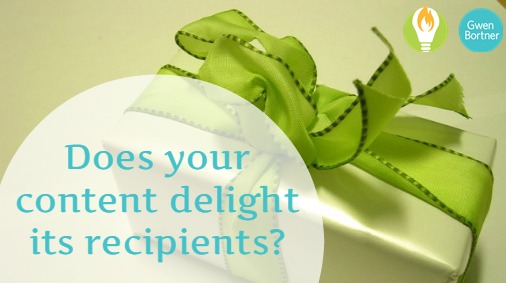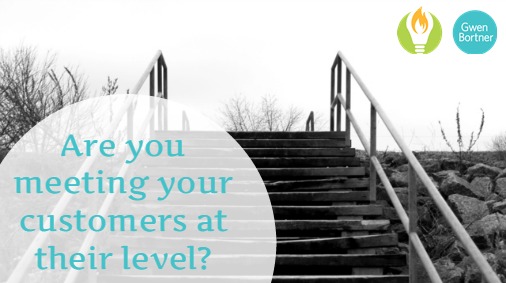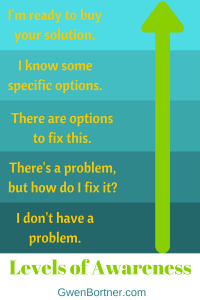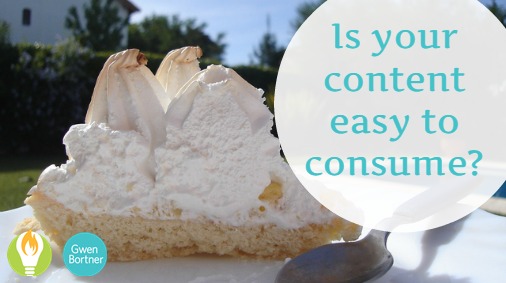
by Gwen Bortner | Tips & Tricks
Have you ever read an article or listened to a presentation and thought – Well, that’s 20 minutes of my life I’ll never get back! Is your audience thinking the same thing about the content you create?
If you’ve ever written an important paper for a school assignment (no matter – ahem – how long ago that might have been!) then you know: it takes research, planning, and time to create something of quality – something that deserves an A+. So… how much time are you putting into the content you create for your business (blog posts, sales pages, newsletters, and more)?
Your audience is inundated with content every single day. If the content you produce isn’t A+ quality, they’re not going to stick around to finish it.
Here are some ways you can improve your content to make it worthy of the people you’re trying to reach:
Share your Wisdom
Just like in school, it’s time to hit the books! Read articles, books, and blog posts on your topic. Educate yourself, and then pass that knowledge along to your audience members. A well-informed audience is more likely to make the decision to buy what you’re selling down the road, so invest the time now to educate them!
Teach a Skill
A type of content that’s usually guaranteed to get good results is the one that teaches a valuable skill. Think about what your audience members would typically type into a search engine, and then write an article or film a tutorial that walks them through the process of learning that skill!
Explain the Why
Last week I reminded you that you can’t sell a solution without first getting your customer to understand that she has a problem. The content you create is a great place to explain to someone WHY they might need the products you sell – to guide them toward an understanding of the problems they face, even if they don’t know it yet.
Assess the Value
How much is your content worth? If you were offered the chance to pay for the information or skills you’re sharing, would you spend money on it? If not, then it’s not very valuable even if it’s free! If you seek to always create content that’s worth paying for, then your customers will feel like they’ve gotten so many freebies from you already that they’re happy to pay you for the “next level” content you want to sell. They will believe in the value of your gated-entry paid products and services because they’ve experienced that value first-hand in your free content.
Pro Tip: The value in your content should be for your audience, not yourself! YOU are most likely NOT a member of your own target demographic. (A classic example: if you sell handmade quilts, the value of the quilt should be the price a non-quilter is willing to pay for the skill that went into it! It’s not the value as perceived by someone who could make their own quilt.)
Listen and Serve
When you give someone a gift they don’t like, you can see the disappointment on their faces. The reverse is also true: when you’ve done your research and purchased that perfect item someone will love, they light up when they receive it. Your content is no different – it should be a gift that you hand-selected for your audience, based on their needs, desires, and pain points. Make it a point to listen to your customers, and always deliver content that solves the problems they’re having in the moment.
If you’re not regularly taking the time to create high-quality content that serves your audience and brings in new business, why are you wasting any time or money creating it in the first place?
If you know your content is lacking and you’re ready to do something about it, join us in June as we read Epic Content Marketing with the Small Biz Book Club! We’ll learn how to create high-quality content that serves our readers and helps them see the value in what we have to offer the world. Enter your information in the form below to join us for the book club:

by Gwen Bortner | Marketing
A lot of entrepreneurs are in the problem-solving business: we help people do the things that will make life better. We solve the problems they know they have and sometimes, the problems they don’t. Are you helping your customers solve the problems they know about, or are you trying too soon to fix a problem they don’t know they have?
You understand that your product or service can solve someone’s problem. The question is: does your customer understand that, too? You can’t fix someone’s problem for them if they don’t know they have it. (A quick and easy example: I’m not currently in the market for termite services, but if you came to my house and showed me proof of termite damage, I’d suddenly BE in the market for those services. You’ve got to help me see the problem before I’m willing to pay for the solution.)
There are five basic levels of awareness that your customers have when it comes to their problems. Your job is to meet them at their current level and help them move toward the higher ones. I’ll use the example of a brick and mortar shop owner without a website as our sample customer.
Level 1: Ignorance isn’t Bliss
At this stage, your customer doesn’t know there’s a problem, at all. He’s a local toy store owner who is making occasional sales from customers who walk in off the street, and he thinks that’s pretty good! What more does he need? Nothing, as far as he’s concerned.
Level 2: Tip of the Iceberg
At this stage, your customer knows he has a problem, but has NO idea how to fix it. He probably thinks something like, “I’m not making enough sales to keep paying my rent on this shop.” So he realizes that he should be making more sales, but he isn’t sure how to go about doing that.
Level 3: Basic Awareness
At this stage, your customer knows that there might be options out there to solve his problem. He has seen other business owners employ sign wavers outside their shops, and he thinks maybe he should do that. He has also considered that maybe he needs a website like the store owner next door. He knows he has options, but he can’t connect those options to specific goals or results.
Level 4: Moving toward Choice
At this stage, your customer knows that if he had a website he could probably make more sales, but he isn’t sure the best way to do that. Should he hire someone to build it for him, or attempt a DIY solution? The choices are overwhelming, even though he already has an idea of a path to pursue.
Level 5: Solution-Ready
At this stage, your customer knows that he needs a website, and that you’re the best person to build it for him. He has already done research and has followed you on social media or visited your website so that he understands the credibility you bring to the table. At this stage he is ready to buy, and all you have to do is offer him something to purchase.
When you create a piece of content, like a blog post or email newsletter, you need to first think about the level of awareness your prospective customer has when he’s reading that content. Write the content to move him from one level up to the next, so that you can guide him on the path that will eventually lead to buying from you.
When you’re building your website or other platform, you should have content that appeals to your audience at the first four levels, because you never know someone’s level of awareness when they first come into contact with your work. As you grow your business, you can build sales funnels that start at each level (1-4), and move the customer up to level 5 with carefully crafted content.
Need a reminder? Download this free graphic to help you remember to move your audience through the levels! Just click on the image to save it to your computer:

Are most of your customers coming to you at one specific level? How can you create content that will help them advance to the next one?
If you’d like to improve YOUR content marketing and speak to people at all levels of awareness, join us in June as we read Epic Content Marketing in the Small Biz Book Club! Throughout the month you’ll learn how to create content that meets your customers where they are and moves them through your sales cycle. Sign up below to join us in the club!

by Gwen Bortner | Tips & Tricks
Creating content is a valuable way to forge a connection with your customers and prospective customers. Having quality content on your website brings your customers back to your “home base” on a regular schedule, and communicates the idea that you are a trusted authority in your niche.
Have I convinced you yet that content is the key to building your business? Last week we talked about how to get the most out of one piece of content, and so this week I want to talk about streamlining that content for two reasons:
- Your customers will connect with your content more easily if it’s easy to consume and has a clear purpose.
- You will have an easier time writing the content if you have a clear plan before you begin.
What’s your purpose?
Before you begin to write any piece of content, you should think about your purpose in doing so. Is it…
- to entertain?
- to inform or educate?
- to sell something?
There’s a place for all of these purposes in the content plan for almost every business. Sometimes, it’s even good to combine them – after all, a dry piece of educational content isn’t nearly as fun to read as a witty, entertaining piece of content that also helps you learn something along the way, right? As another example, some of the best sales emails are written with educational content up front and a sales pitch at the end. Where you get into “content trouble” is not knowing what you’re trying to do with your content, or how you will use these three types of content individually or in pairs.
Before you create any piece of content, think first what you most want the customer to do when she finishes with the content, and use that as your overall purpose.
Dividing up the Content Pie
If you think of the content you put out into the world as a pie, how many slices are you devoting to sales content, vs. educational or entertaining content? The answer should be: “not many!” The purpose of a sales pitch is to offer a customer something right in the moment that he’s ready to buy it; but that customer has to have at least a few interactions with you before he’s ready to buy anything. Most people don’t just show up on your website and immediately purchase the first thing they see.
The amount of interaction required will vary with several factors, including:
- the cost of the item you’re selling
- the relationship you’ve built up in your industry
- the customer’s frustration level with his current situation
- your product’s likely ability to remove his frustration
Think of every piece of content you create as a way to build a relationship with someone who will eventually buy your products or services. How will you introduce that customer to you, your business, and your ability to solve his problems? Use your content to explain that!
Making a Call to Action
When you create content, you should have not only one purpose in mind, but also one action you want the customer to take. If you’re asking someone to click a link here to read a blog post, and then sign up over there for another list, and then find a download in this other place – that’s too many choices. Give your customer ONE thing to do, and it’s more likely that she’s actually going to do it.
Here are some sample calls to action you can make with a single piece of content:
- sign up for an email list
- download something (a free PDF or ebook or resource guide)
- click “like” or “share” or “retweet”
- forward the email to a friend
- hit reply and answer a question
- purchase something
So, to sum up: pick one focus, create plenty of opportunities for your customers to connect with you via content without selling them anything, and pick ONE call to action to bring your reader closer to being a buyer and lifelong fan. Not only will this process make it easier for you to create content, but it makes the content more likely to connect with your audience. It’s a win-win for everyone!
Did you find THIS content interesting or helpful? Share it with your friends & followers! Click the link to tweet this:






